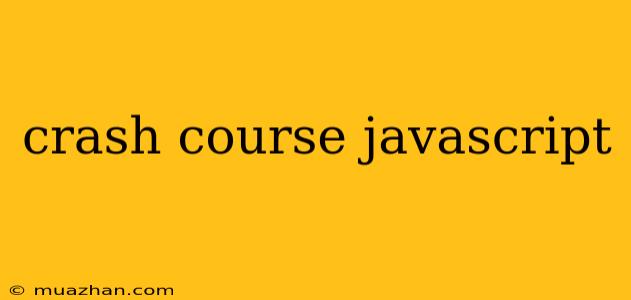Crash Course: JavaScript - From Zero to Hero
JavaScript, often shortened to JS, is a versatile and powerful programming language that is essential for web development. It allows you to add interactivity, animations, and dynamic content to websites. This crash course will guide you through the fundamental concepts of JavaScript, enabling you to start writing your own code.
1. Variables and Data Types
- Variables: Variables are containers for storing information. You can think of them like labeled boxes where you can put data. To declare a variable in JavaScript, you use the
letkeyword.let name = "John Doe"; let age = 30; - Data Types: JavaScript has several built-in data types:
- String: Text enclosed in single or double quotes (e.g., "Hello World").
- Number: Numerical values (e.g., 10, 3.14).
- Boolean: True or false values.
- Array: An ordered collection of values.
- Object: A collection of key-value pairs.
2. Operators
Operators allow you to perform operations on variables and values. Some common operators include:
- Arithmetic Operators: +, -, *, /, %
- Comparison Operators: ==, !=, >, <, >=, <=
- Logical Operators: && (AND), || (OR), ! (NOT)
3. Control Flow
Control flow statements determine the order in which code is executed.
- if/else Statements: Used to execute different blocks of code based on a condition.
let age = 18; if (age >= 18) { console.log("You are eligible to vote."); } else { console.log("You are not eligible to vote yet."); } - Loops: Used to repeatedly execute code.
- for Loop: Executes a block of code a specified number of times.
- while Loop: Executes a block of code as long as a condition is true.
4. Functions
Functions are reusable blocks of code that perform specific tasks. They help to organize and modularize your code.
- Defining a Function:
function greet(name) { console.log("Hello, " + name + "!"); } - Calling a Function:
greet("John"); // Output: Hello, John!
5. DOM Manipulation
DOM (Document Object Model) represents the structure of an HTML document as a tree-like hierarchy. JavaScript can interact with the DOM to change the content, style, and behavior of web pages.
- Selecting Elements: Use methods like
getElementById(),querySelector(), orquerySelectorAll(). - Modifying Content: Use properties like
innerHTMLortextContent. - Adding and Removing Elements: Use methods like
appendChild(),removeChild(), andcreateElement().
6. Events
Events are actions that occur in a web page, such as clicking a button or hovering over an element. JavaScript can listen for and respond to these events.
- Event Listeners: Use
addEventListener()to attach a function to an event.let button = document.getElementById("myButton"); button.addEventListener("click", function() { console.log("Button clicked!"); }); - Common Events:
click,mouseover,mouseout,keydown,keyup, etc.
7. Conclusion
This crash course provides a basic foundation for learning JavaScript. Keep practicing, experiment, and explore more advanced topics like arrays, objects, and asynchronous programming to become a proficient JavaScript developer.
Remember, the best way to learn is by doing! Start building your own projects and explore the endless possibilities that JavaScript offers.
